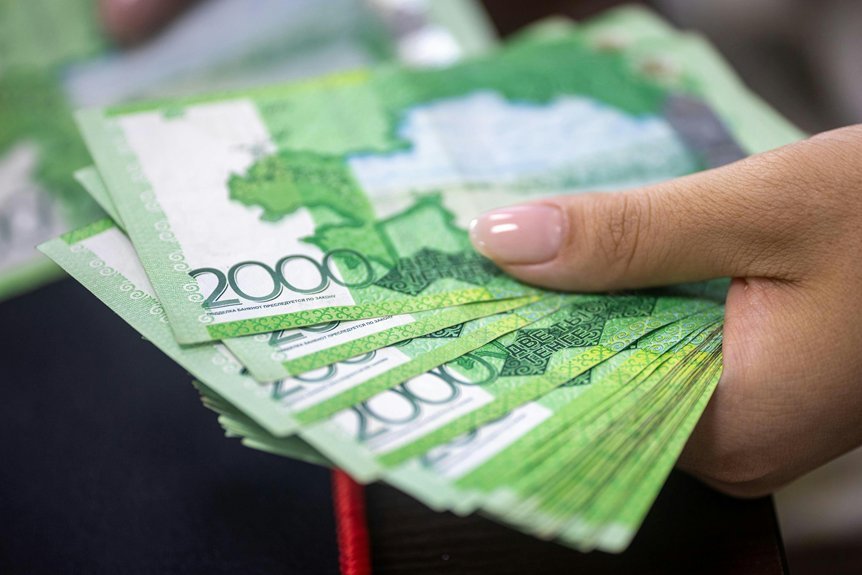When it comes to the intricacies of currency exchange, the 100 Baisa note from the Central Bank of Oman offers a fascinating glimpse into economic dynamics. Currently valued at around 2.6 Indian Rupees, this denomination plays a pivotal role in trade between Oman and India. Understanding the factors that influence this exchange rate can reveal deeper insights into their economic relationship, but several variables could sway its future stability. What might these fluctuations mean for both nations?
Key Takeaways
- The current exchange rate for 100 Baisa is approximately 2.6 Indian Rupees.
- The Omani Baisa is subdivided into 1,000 units for precise transactions.
- Exchange rates fluctuate based on economic indicators like inflation and GDP growth.
- The Central Bank of Oman ensures stability in the Baisa, enhancing investor confidence.
- Understanding the Baisa’s value is crucial for financial planning involving Oman and India.
Overview of the Omani Baisa
The Omani Baisa, a fundamental unit of currency in Oman, plays an essential role in the nation’s economy.
Introduced in 1973 as part of the Omani currency system, the Baisa replaced the Indian Rupee at a rate of 1 Baisa to 1.3 Indian Rupees. This shift marked a significant moment in Baisa history, establishing the Baisa as a stable currency.
The Baisa is subdivided into 1,000 units, ensuring precise transactions and facilitating trade. Its stability has attracted foreign investment, underscoring the importance of the Baisa in both local and international markets.
Understanding this currency is vital for economic engagement.
Current Exchange Rate of 100 Baisa to Indian Rupees
Currently, 100 Baisa exchanges for approximately 2.6 Indian Rupees. Understanding the value of baisa denominations is essential for your financial decisions. The exchange rate fluctuates based on various economic factors, so staying informed helps you navigate currency symbols effectively.
| Baisa Denominations | Indian Rupees |
|---|---|
| 100 Baisa | 2.6 |
| 200 Baisa | 5.2 |
| 500 Baisa | 13.0 |
| 1000 Baisa | 26.0 |
Historical Exchange Trends Between Omani Baisa and Indian Rupee
Exchange rates between the Omani Baisa and the Indian Rupee have shown significant fluctuations over the years, influenced by various economic conditions and geopolitical events.
Exchange rates between the Omani Baisa and the Indian Rupee reflect a dynamic history shaped by economic and geopolitical factors.
You’ll notice three key trends in baisa history that reflect rupee trends:
- 1980s Stability: The exchange rate remained relatively stable, with minimal fluctuations due to consistent economic policies.
- 1990s Volatility: Political instability in the region led to dramatic shifts in exchange rates, impacting trade.
- 2000s Growth: Economic reforms in India and Oman strengthened bilateral trade, resulting in a more favorable exchange rate for the baisa against the rupee.
These trends highlight the complex interplay between both currencies.
Factors Influencing the Exchange Rate
When analyzing the exchange rate between the Omani Baisa and the Indian Rupee, you need to contemplate key economic indicators such as inflation rates and GDP growth.
These factors can markedly impact currency strength and investor confidence.
Additionally, the political stability of both nations plays an essential role in determining exchange rate fluctuations, affecting trade and investment flows.
Economic Indicators Impact
As economic conditions fluctuate, various indicators greatly influence the exchange rate between the Central Bank of Oman’s 100 baisa and the Indian rupee.
Key factors impacting this currency valuation include:
- Economic Growth: Strong growth in Oman or India can enhance currency strength, affecting exchange rates.
- Inflation Rates: Higher inflation in a country typically devalues its currency, impacting exchange rates.
- Interest Rates: Changes in interest rates can attract foreign investment, influencing currency demand and valuation.
Understanding these indicators helps you predict and analyze exchange rate movements effectively.
Political Stability Effects
Political stability greatly impacts the exchange rate between the Central Bank of Oman’s 100 baisa and the Indian rupee. When a nation enjoys political stability, it typically fosters an environment conducive to economic growth, attracting foreign investment and enhancing trade relations.
Conversely, political turmoil can lead to uncertainty, causing investors to withdraw capital and decreasing currency value. For instance, fluctuations in the Indian political landscape can directly affect the rupee’s strength against the baisa.
Consequently, monitoring political developments in both Oman and India is crucial for understanding potential shifts in exchange rates and making informed financial decisions.
Economic Relations Between Oman and India
Although Oman and India are separated by vast distances, their economic relations have flourished greatly over the years.
Key factors driving this growth include:
Key factors fueling the economic ties between Oman and India include trade partnerships, remittance flows, and investment opportunities.
- Trade Partnerships: Bilateral trade has expanded, with India being one of Oman’s top trading partners.
- Remittance Flows: Indian expatriates contribute substantially to Oman’s economy, sending substantial remittances back home, which bolsters India’s foreign exchange reserves.
- Investment Opportunities: Both countries are exploring avenues for investment in sectors like energy, infrastructure, and technology.
These elements illustrate the interdependence and mutual benefits that define the economic ties between Oman and India, enhancing their global economic footprint.
Impact of Currency Fluctuations on Trade
Currency fluctuations considerably influence trade dynamics between Oman and India, affecting pricing, competitiveness, and overall economic stability.
When currency volatility occurs, it alters the cost of imported goods and services, which can lead to increased prices for consumers. For instance, if the Indian rupee weakens against the Omani rial, Indian exports may become more expensive for Oman, reducing demand.
Conversely, Omani products could become more affordable in India, boosting exports. This interplay directly impacts trade volumes and profit margins, compelling businesses to adapt strategies to mitigate risks associated with currency fluctuations and maintain competitive advantages in both markets.
How to Exchange 100 Baisa for Indian Rupees
When you’re looking to exchange 100 baisa for Indian rupees, understanding the current exchange rate is key. Here’s how to do it effectively:
- Research Exchange Rates: Use reliable financial websites or apps to find the latest rates for currency exchange.
- Choose a Trusted Provider: Opt for banks or recognized currency exchange services to guarantee security and fair rates.
- Complete the Transaction: Visit the selected provider with your 100 baisa, and facilitate the exchange, keeping in mind any fees that might apply.
Future Projections for the Omani Baisa
How will the future of the Omani baisa unfold in the next few years? Analysts predict that future trends indicate a potential for enhanced currency stability, driven by Oman’s economic diversification efforts.
Future trends suggest enhanced stability for the Omani baisa, supported by economic diversification efforts.
As the government invests in sectors like tourism and manufacturing, you might see increased demand for the baisa.
Furthermore, global oil prices will continue to influence its value, as oil remains a key revenue source.
Keeping an eye on geopolitical factors is essential, as they could introduce volatility.
Tips for Travelers: Currency Considerations
While planning your trip to Oman, it’s crucial to understand the implications of using the Omani baisa in daily transactions.
Proper currency exchange can greatly impact your travel budget. Here are some tips to take into account:
- Exchange Rates: Always check current exchange rates to verify you’re getting a fair deal.
- Local ATMs: Withdraw cash from local ATMs for better rates compared to currency exchange counters.
- Payment Methods: Familiarize yourself with where credit cards are accepted, as many places prefer cash transactions.
Taking these factors into account will help you manage your finances effectively during your trip.
Conclusion on the Economic Significance of the Omani Baisa
Understanding the economic significance of the Omani baisa reveals its vital role in both local and regional markets. The baisa serves as a stable currency, reflecting Oman’s economic stability and facilitating trade.
Its significance extends beyond borders, impacting exchange rates and investment flows in the Gulf region. The economic implications of the baisa influence inflation rates, purchasing power, and consumer confidence.
Additionally, the baisa’s fixed exchange rate against the US dollar bolsters investor trust. Therefore, recognizing the baisa’s importance can help you navigate Oman’s economic landscape effectively, guiding strategic decisions in both business and travel.
Conclusion
In summary, the Omani Baisa plays an essential role in facilitating trade between Oman and India, with a current exchange rate of approximately 2.6 Indian Rupees. Significantly, trade between these nations has surged by over 60% in the past five years, highlighting the growing economic ties. As you navigate currency exchanges, understanding the stability and significance of the Omani Baisa can enhance your financial decisions and investment opportunities in this dynamic market.



